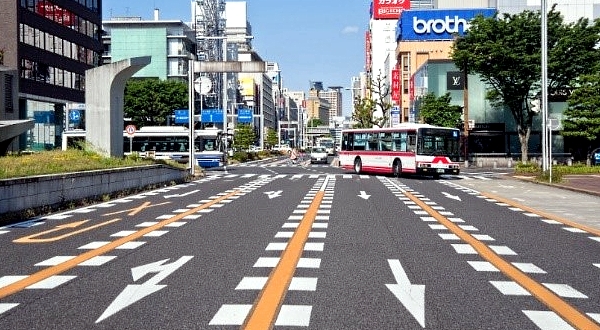
By Lee San
When I was young, grandma always told me to help her look for white hair on her head. The reward was 10 cents each strand. Interesting huh!
Whenever I was taking a tour group to Japan, I would invariably set a problem for the members: Look carefully at the asphalt roads here, try to find a pothole or crack. If you manage to get one, I'll reward you with 7-Eleven's famous anpan (sweet red bean bun).
You mustn't think it's a free giveaway. Finding a pothole on a Japanese asphalt road could be a tall order! Disappointed? Sure enough grandma might lose a few dimes every now and then, but going all out to find fault with Japanese asphalt pavement might still win you an anpan or two.
The thing is: that scarce imperfection in a Japanese road goes very well with their "wabi sabi" (侘寂) philosophy, literally meaning simplicity and quietness, the aesthetics of appreciating imperfections, coarseness on the outside but impeccability on the inside. As such, the Japanese are known to regularly spray wash their asphalt roads, probably to mask the imperfections!?
So, everything that crosses your path in Japan is not just meant for your eyes only, but to be appreciated with all your five senses, comparing its internal and external beauty as well as practicality.
As a matter of fact, the appreciation of Japan's asphalt roads is among the highlights of the country's "enjoy and experience" attractions for me.
Indeed, the Japanese are very particular when it comes to smoothness, drainage as well as safety aspects of the asphalt pavement. The quality of pavement in Japan is among the best in the world. The surface is pitch dark in color, soft and exceptionally durable, and will not wear out your tires, thanks to the superior quality of natural bitumen suitably mixed with high quality locally processed additives. So far only a handful of Scandinavian countries, Germany and Singapore can boast comparable pavement quality. Notably, China has made remarkable improvements over the last ten years in its own environment-friendly asphalt pavement technology, and is catching up very fast.
There was this time we bumped into a team of technicians patching the asphalt pavement in an alley in Kyoto. Guess what? I willingly took out my wallet to buy everyone the promised 7-Eleven anpan. What a rare chance for me to lose a bet!
So I took the opportunity to turn on the mic and declared: The professional Japanese technicians are not merely mending a road, they are also restoring a piece of artwork!
While munching the anpan, the group members stared at me in bewilderment.
Look! After carefully taking the measurements, these technicians in full working gear start running their muted road cutters, and then use a vacuum cleaner to suck off the debris. As if that's not enough, they are doing so with minimal disruption caused to nearby residents and businesses as well as pedestrians and vehicles.
If you take a closer look, you will realize that the Japanese won't anyhow patch up the road surface just to cover up the defect. Instead, they will redo a new "four-layered cake"consisting of subgrade, sub-base course, base course and surface course — layer by layer and properly pressed to firmness.
Moreover, they must make sure the newly paved asphalt is of largely identical color as the existing one for visual consistency, smoothness and not water-logging.
The entire road restoration process perfectly embodies the essence of superior Japanese craftsmanship and utter attention to detail while ensuring the newly paved surface will not compromise in future.
That's why I say Japanese roads are a key attraction any visitor to the country should seriously learn to appreciate.
Look again! The white lines painted on the road surface are so neat and clean, no slightest sign of fading.
Asphalt first came into being in Scotland some 200 years ago, around 1820AD. I checked the encyclopedia and learned that one day Scottish engineer McAdam accidentally found the gravel road surface "contaminated" with something like bitumen, but it was nevertheless good. After doing some research on it, he mixed several other substances to the so-called bitumen to come up with the world's first ever asphalt building technology, the patented Macadam technique. A hundred years later in 1920, his company developed an improved version of asphalt and road construction technique, the Tarmacadam technique which has since been adopted in Japan and EU countries today. I realize that newly constructed roads in Vietnam are beginning to adopt this technology, too.
In Chinese, roads are generally called "马路" (ma-lu) firstly because they are "ma-ca-dam-lu', hence abbreviated as "ma-lu". Secondly. Before cars were invented, roads were primarily used by horses (ma), and are therefore called "ma-lu" (horse road).
As a matter of fact, many developing countries are rushing to upgrade existing rock hard grayish concrete roads into softer and more durable black asphalt roads using the T Macadam technique, or there're some untold secrets in doing so, such as taking the state's asphalt budget to do a grayish white asphalt road of lesser quality? You know what I mean when you're on the road, right?
Whatever kind of road it is, be it a dirt road, mud road, gravel road or a potholed road, a road has come into existence because people long before us walked it, step by step, day after day, and year after year. In the end, it becomes a passage that links man to man.
P/S: I have no idea when I will take you along for a holiday again. Meanwhile, let's do the traveling between the lines.
(Lee San is Founder and Group Executive Chairman of Apple Vacations. He has traveled to 132 countries, six continents, and enjoys sharing his travel stories and insights. He has also authored five books.)
ADVERTISEMENT
ADVERTISEMENT


































